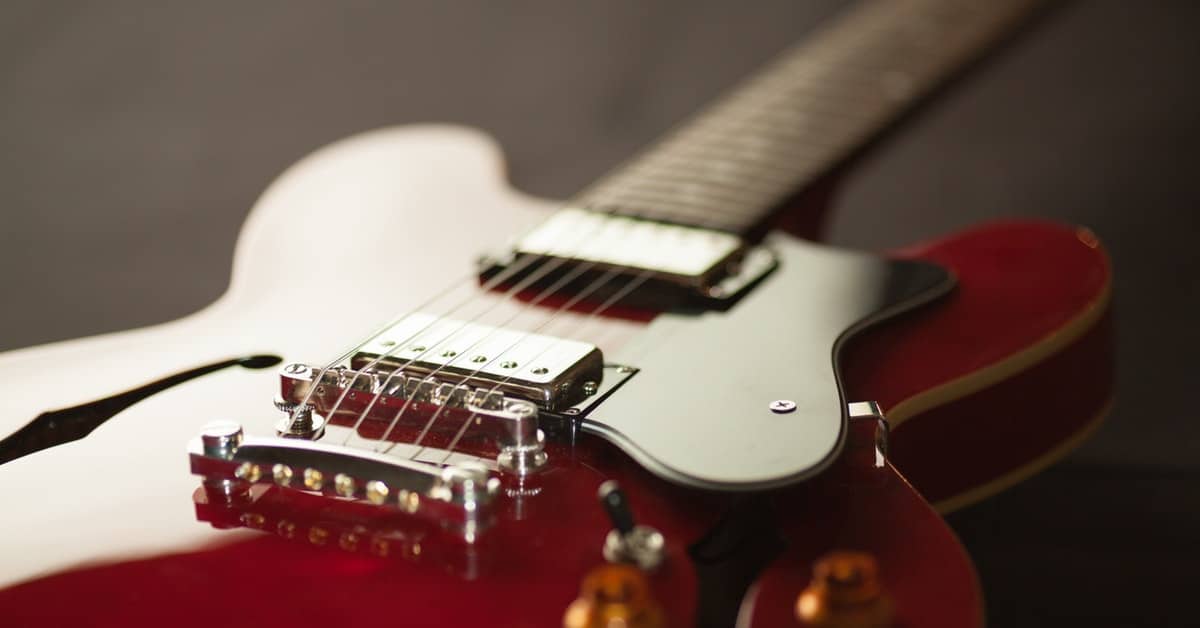My Guitars and set up.
This is my guitars and pedal set up.
I would classify my guitar playing style as British blues. I am also a big fan of British invasion music because that what I grew up with.
EFFECTS
Back in the old days I was a purist snob refusing to use any kind of pedal and played through a 100 watt Marshall stack with three 4 x 12 cabinets (only two were plugged in, no reason, it just looked cool). Today I have embraced pedals. I use discrete pedals primarily, but I have a Vox Tone-lab ( the blue tabletop one) and a Sans Amp to record.
My first pedalboard was just a rectangular piece of plywood that I painted black. I used plumber’s metal pipe strapping that I bent, taped and then screwed into the board to secure the pedals. This way I didn’t have to physically modify any pedals.
Since then I have redesigned the board. Click here for detail on how I built it My new pedal-board
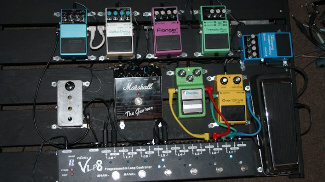
Running right to left starting with a Boss compressor, then a Vox wah wah. Then an old OD1 (which I modified so that the LED. stays on) Then a Tube Screamer. After that a Marshall Gov’Nor. The unmarked box is a clone that I made of the LPB-1.
When I send that I don’t have enough volume I kick this guy one. It does the job. The Boss pedals in the back are ( l-R) Tremolo-Pan, a Flanger, a delay, and a Harmonizer. The Vlp* is a programmable signal router. It is set to select either one of my distortion boxes or a combo of two. The rest are chained together.
All of this is powered by a custom-made regulated power supply that I designed myself and built. It has the following outputs (-9, +9, +/-9, +12). Without the power supply, I would go broke buying batteries. There’s this story about Eric Johnson (the tone freak) being able to tell a brand of battery by the tone of the pedal. Boss has two types of battery eliminator and I finally found out that while one puts out 9 volts, the other outputs almost 12 volts. The latter is recommended for the chorus, delay, and even their Heavy Metal pedal. Beware of those adjustable volt wall-warts made in China and Taiwan. The voltages rarely are correct. Get yourselves a voltmeter and measure using a 1000-ohm resistor in series with the wall warts output. Measure the voltages.
The room that you play in has probably more to do with your sounds than any other factor. I have found that in some rooms my amp sounds great and in others, I’m ready to chop it up into firewood. One of the reasons that I became a pedal freak is that I want to be able to have a decent controllable sound regardless of the room that I’m working. When your sound is good you worry less and you play better. Always leave yourself time to do a proper soundcheck. If you can afford it, get a wireless transmitter or if your budget is more modest buy a long lead cable. Listen to your sound from afar. Don’t trust anyone except a good sound man who knows what you want.
AMPS
My main amp for many years is a Fender model 75. It was produced for a short period around 1980. It’s similar to a twin but features channel switching. It was Fender’s answer to the Mesa Boogie.
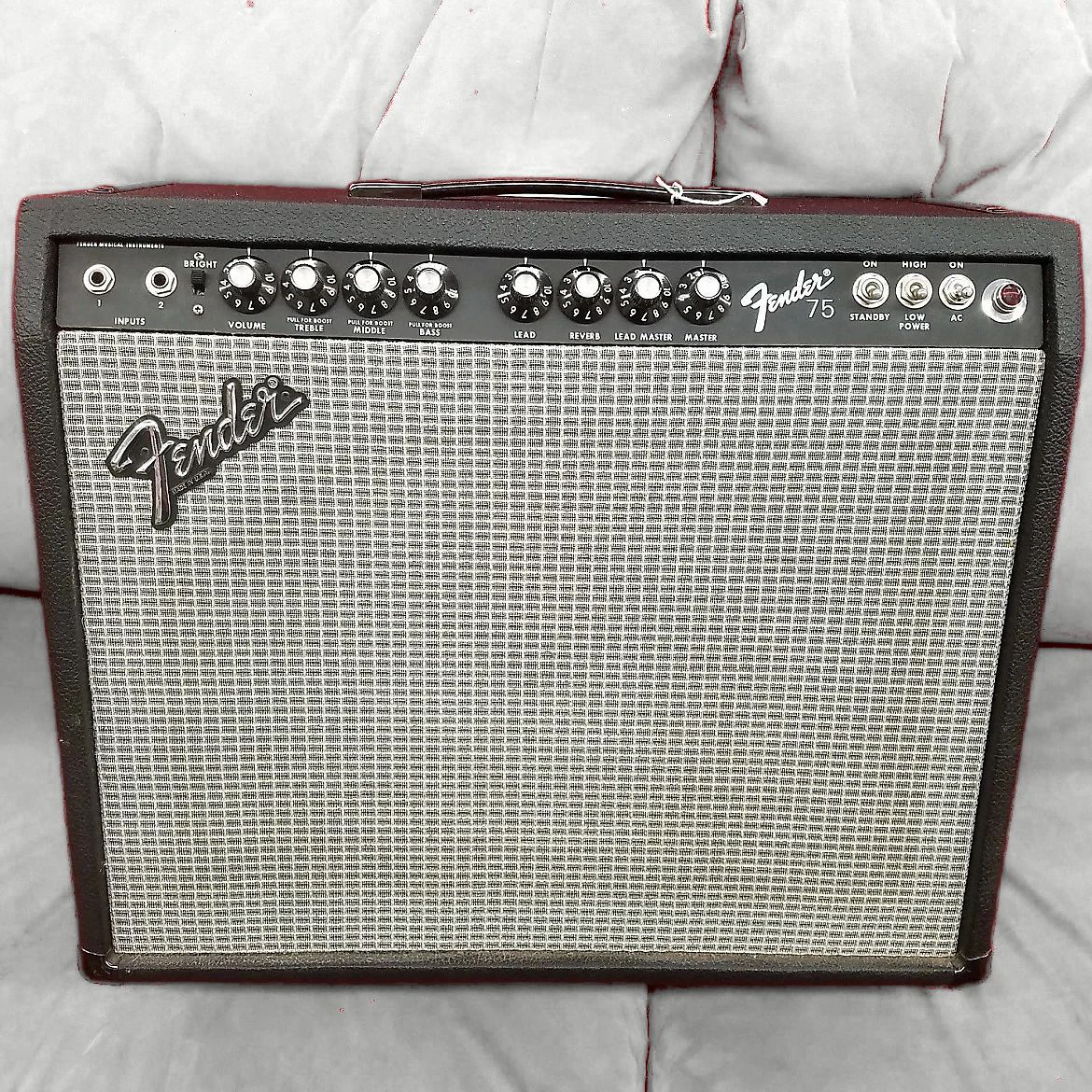
I often miss my old Marshall Plexi 100 watt stack. If you have the money, the strength and a small van, consider a Marshall.

The Fender fits in the trunk of my car. You can probably find an old ’75 for quite a low price. It weighs in at 60 lbs. The circuitry is almost identical to the Twin Reverb. They didn’t last long in the Fender line but they are quite good.
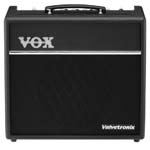
I bought a Vox VT-40 because that old Fender 75 seems to get heavier every year. The VT40+ weighs 24 lbs. I have used the VT40 with a drummer and it was able to cut it.
I have an old Vox Cambridge 30. It had already been fixed and modded. I was rehearsing with a Beatle tribute band so I needed something more Beatle-ish. The Cambridge 30 is loud enough to play over drums. It can sound very clean. This is important when playing Beatles especially the older stuff. The Cambridge 30 weighs about 38 lbs.

I was surprised to see a band ” the Vinyls” using a “Quilter Micro Block 45” This is an amp the size of an effect pedal. You pull it into a speaker and away you. This has inspired me to experiment with a TPA3118 microamp. Stay tuned.
If you are into finding out more about tubes, check out the Aspen Pittman book, The Tube Amp Book. It’s full of info and includes schematics for tons of famous amps.
My first amp (I wish I still owned it) was a National. It was sort of like a Twin but smaller. Then I bought a Sears Silvertone. It didn’t cut it with a drummer and other guitars. I had a Fender Princeton rated at 15 watts that sounded great but useless to jam with. So rather than finding out the hard way try to rent or borrow an amp before buying it. I could say that you need about 30 watts to be heard over a drum but it all depends
GIGGING Tips
I have played gigs for longer than I like to admit. There are many things to check. Some of these are basic. Some are common sense.
Always carry spare strings. I always carry a few new sets and spares of the ones that I tend to break more often. I always carry at least two guitars. Whether you gig for free or get paid no one wants to wait while you are re-stringing. I carry spare batteries, picks, tools, flashlight, tape, wire, spare guitar strap, and soldering kit. Always bring another guitar jack cable. I also bring a pot cleaner.
If at all possible bring a spare amp. If not, bring spare tubes, one of each type. Don’t forget fuses. It’s better to play with a weak tube than not to play at all.
If you carry a PA system bring a spare mike and a spare stand. Things happen no matter how careful you are.
Buy or make some equipment as the movers use. A good hand truck and flat dolly will make your life easier at 4 am when you have to move that 4 x 12 cabinet.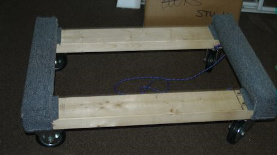
I made this mover’s dolly with some scrap 2 x 4 and bit of Dollar store carpet.
I wear a tennis sweatband because sometimes it’s hard to grab a towel. I always have a change of shirts and tee shirts. I never forget to bring a towel. Baby wipes come in handy especially after wrapping up wires. I now use Velcro strips to hold rolled wires. Tape is way too messy. You can find these Velcro strips at dollar or hardware stores.
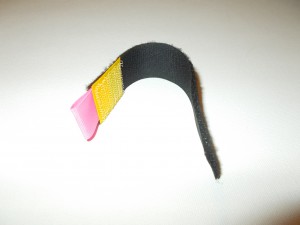
What else? Bring some paper & pens. Sometimes you have to make last-minute adjustments to the setlist because that easy-going pop bar is now frequented by heavy rocking bikers. I like to draw up large setlists on cardboard so that can be taped to the floor and are big enough to read without bending over. A sharpie and some white cardboard is a good idea. Do let your audience wait while you figure what song to do. If the song is on the list then be prepared to play it. If not, get it off the list. Tape your band and listen back and note the dead air. There shouldn’t be any. Have another member introduce the next number if someone needs time to switch instruments or re-tune etc. The pros use the same spiel all the time so when you write down the sets also write down the small talk and rehearse that too. I know a band that has said basically the same stuff for over 30 years. Have backup instruments when possible. Make a list of jokes, maybe the history of the next song, keep the air full. Please remember where you are. Many a pro has made a mistake like “Hello Cleveland” when they were somewhere else. Be prepared. What could go wrong, will go wrong! I had a nervous bass player plug his amp into his amp and his speakers into his speakers. Poof!!!!!!
Eb tuning or Jamming with Jimi
It is a well-known fact Jimi Hendrix tuned mostly in Eb. He also tuned down to D and sometimes in concert pitch. So if you want to blow along with your favourite Jimi song, I suggest you tune down to Eb. In case it’s not clear, you just tune every string down half a tone i.e. Eb Ab Db Gb Bb Eb. An easy way to re-tune is to put a capo on the first fret and tune with a tuner. When you remove the tuner you will be in Eb.
You will soon see that almost everyone that was ever influenced By Hendrix was tuned down all the time or at least on some recording. Just a few names: Stevie Ray Vaughan, Robin Trower, Yngwie Malmsteen, Frank Marino, Kenny Wayne Shepherd, the late great Eddy Van Halen. There is a way to jam along without re-tuning. Find a WinAmp plug-in called Pacemaker. You can slow down a song without affecting the pitch or lower the pitch without affecting the speed. It’s great for learning riffs. There was “Riffmaster Pro”. It seems to have gone the way of the dodo. You may be able to find a demo version or a not-so-legal version still out there. It was quite good. You could slow riffs down, loop the riff down to a note. It made working out riffs easy.
Although they never were linked to Hendrix, what famous group often performed in Eb ?
The Beatles often tuned to Eb in concert. It was probably to save their voices. On both the first and third Sullivan shows (taped the same day). This is when George Harrison was sick with the flu. The Washington show, one of the Buddakan (Japan) shows were also in Eb. This has never been documented anywhere to my knowledge and never even been discussed in interviews. I hear studio tracks also in Eb. Any comments, Sir Paul?????
Another interesting tuning is DADGAD. Laurence Juber and Jimmy Page used this a lot. I haven’t yet tried this but check out Laurence Juber on YOUTUBE.
Easy quick Slide Tuning
Years ago when I had only two guitars I needed a way to play open tuning slide without having to tune to open D or G. I chose open G By lowering 1 string, E to D. I now had DGBD on the 4 higher strings which form a G chord. It is a great slide tuning as long as you forget about the lower E and A strings. I also use this for Honky Tonk Woman.
Guitars
I have played Gibson’s, Fenders, and Ibanez. I suppose that I am partial to Les Paul’s and Strat’s. The loudest Guitar that I ever owned was a 50’s something Les Paul JR., the same kind that Leslie West used in Mountain. Coupled with a Marshall 100 watt it was a monster.
Don’t just buy a certain guitar just because your idol plays one. Your idol may have bigger or smaller hands than you, stronger fingers, etc. If it feels and sounds good then consider it. Always try to buy a well-known brand and/or popular model. This will help if you ever want to sell it. So often I see friends ending up with whatever the local music store stocked. I got caught this way many years ago. I wanted a Gibson reverse Firebird but the delivery was far too long. I settled for an SG. Within a year or so all my favourite guitar idols were using SG’s.
Since eBay came around it’s hard to find a good used guitar and at a reasonable price. Paying huge sums of money for a guitar should be strictly reserved for people that have too much money to burn. There is hope though. When I started playing, Asian-made guitars were crap. That has totally changed. I used to own a 57 Les Paul Gold top, not a re-issue but the real McCoy. I was so paranoid that someone would steal it, that I finally sold it and used it for a down payment on my house. You want a guitar that you can play and that isn’t worth a king’s ransom. When I started playing you could buy a used Les Paul sunburst for $100.00. A friend of mine bought a 50’s something Strat for $80.00. They were cheaper than buying some crappy Japanese guitars. Over the last few years I have bought a few Chinese guitars and I am sold on them.
I bought an Electric 12 string Hawk by Jay Turser. Want to get that Byrds, Beatles sound without getting a second mortgage then buy one of these. It’s great and it’s a beautiful-looking axe. I paid $225.00 US new. It’s made in China. Nobody I know personally ever owned an electric 12 string. I also bought an Epiphone EJ160e, acoustic-electric. I had a Jay Turser Strat copy. It’s a good guitar. I bought a Gretsch 6122 Country Classic, made in Japan and it’s the most beautiful guitar that I ever owned. Don’t let anyone tell you that these aren’t fine instruments. I bought a Korean Epiphone Casino and a couple of Indonesian Squire Strats. They are all great. I’m sorry to say but if you can’t play an Asian-made guitar well, you aren’t going to play an American-made one any better. If you can, bring an experienced ( but unbiased) guitar player with you when you need to buy a guitar. You don’t have to change every part of an Asian guitar either. I remember back in the old days all these guys were changing their tuners. You need to sound good playing acoustically. It’s all in the fingers and attack. A lot of young guitar players when bending strings but go out of bounds. Record yourself. I used to sound like I was slaughtering chickens. Actually, if you listen to Janis Joplin’s first band, the lead playing was atrocious. You have to train yourself to know what is good and what is flat and annoying.
If you are handy, don’t be afraid of working on your axe. Sure an expert luthier is priceless but you can easily do lots of rudimentary adjustments. There are tonnes of youtube videos out there to teach you. I now adjust my truss rods. I have even replaced a neck and soon I will try my hand at re-fretting and re-finishing. Please don’t experiment on a $5000.00 guitar.
Here is a very interesting article about which guitars are best for your style of music
Guitar is one of the most popular instruments in the world, used in genres from rock and heavy metal to jazz and highlife. It’s no surprise, then, that various different guitars have evolved to suit…
Source: The Best Electric Guitars For Each Genre | Beginner Guitar HQ
Here is another good article on choosing an acoustic guitar
At BeginnerGuitarHQ, we aim to help you learn to become a great guitarist. When learning this valuable skill, you need the equipment to go with it, so we put together helpful reviews that’ll give you…
Source: Best Guild Acoustic Guitar | Beginner Guitar HQ
Here is another interesting article about the different types of electric guitars.
Different Types of Electric Guitars – Important features of solid body (Fender and Gibson), Semi hollow, Hollow body, Electric Acoustic & 7/8 string guitars.
Source: Different Types of Electric Guitars | The Music Ambition
At BeginnerGuitarHQ, we want to keep you on top of everything available to you in the world of guitars, and music in general. You might think of acoustic guitars as a singular entity, but we want to…
At BeginnerGuitarHQ, we want to keep you on top of everything available to you in the world of guitars, and music in general. You might think of acoustic guitars as a singular entity, but we want to…
Source: The Different Types Of Acoustic Guitars, Explained | Beginner Guitar HQ
Stevie Ray Vaughan Guitar Gear – How to Play Like Stevie Ray Vaughan
Source: Stevie Ray Vaughan Guitar Gear – How to Play Like Stevie Ray Vaughan | Beginner Guitar HQ
We also have a YouTube channel.



